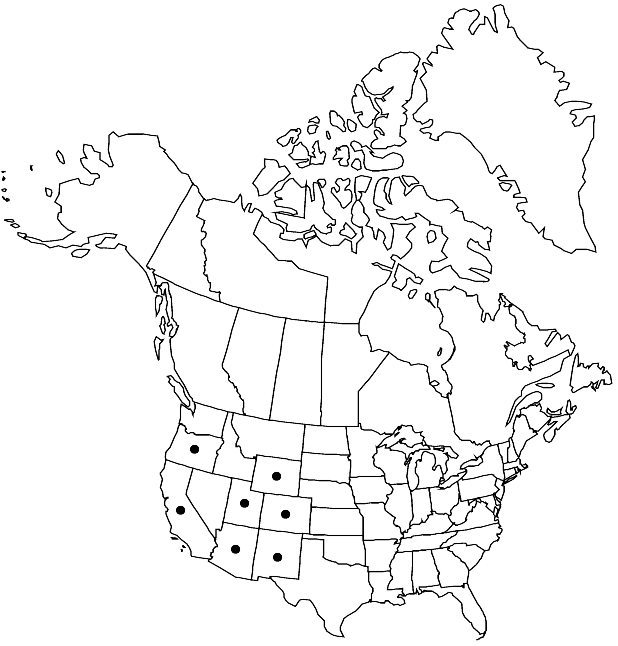Difference between revisions of "Salix ligulifolia"
J. Arnold Arbor. 2: 188. 1922.
FNA>Volume Importer |
FNA>Volume Importer |
||
| Line 30: | Line 30: | ||
|elevation=0-3100 m | |elevation=0-3100 m | ||
|distribution=Ariz.;Calif.;Colo.;N.Mex.;Oreg.;Utah;Wyo. | |distribution=Ariz.;Calif.;Colo.;N.Mex.;Oreg.;Utah;Wyo. | ||
| − | |discussion=<p>Salix ligulifolia sometimes has leaf teeth that are so short that it is referred to as “entire-leaved.” That condition is uncommon and, even when some leaves appear to be entire, others with fine serrulations can be found on the same plant.</p><!-- | + | |discussion=<p><i>Salix ligulifolia</i> sometimes has leaf teeth that are so short that it is referred to as “entire-leaved.” That condition is uncommon and, even when some leaves appear to be entire, others with fine serrulations can be found on the same plant.</p><!-- |
--><p>Hybrids:</p><!-- | --><p>Hybrids:</p><!-- | ||
| − | --><p>Salix ligulifolia forms natural hybrids with S. geyeriana.</p> | + | --><p><i>Salix ligulifolia</i> forms natural hybrids with <i>S. geyeriana</i>.</p> |
|tables= | |tables= | ||
|references= | |references= | ||
| Line 56: | Line 56: | ||
|publication year=1922 | |publication year=1922 | ||
|special status= | |special status= | ||
| − | |source xml=https://jpend@bitbucket.org/aafc-mbb/fna-data-curation.git/src/ | + | |source xml=https://jpend@bitbucket.org/aafc-mbb/fna-data-curation.git/src/8f726806613d60c220dc4493de13607dd3150896/coarse_grained_fna_xml/V7/V7_127.xml |
|genus=Salix | |genus=Salix | ||
|subgenus=Salix subg. Vetrix | |subgenus=Salix subg. Vetrix | ||
Revision as of 17:55, 18 September 2019
Shrubs, 1–8 m. Stems: branches yellow-brown, gray-brown, or red-brown, not glaucous, glabrous or villous; branchlets yellow-green or yellow-brown, glabrous, sparsely to densely villous, or velvety, (inner membranaceous bud-scale layer free, not separating from outer layer). Leaves: stipules foliaceous, apex rounded, convex, acute or acuminate; petiole convex to flat, or shallowly grooved adaxially, 3–18 mm, glabrous, pilose, or velvety to glabrescent adaxially; largest medial blade lorate, narrowly oblong, or narrowly elliptic, 60–133 × 12–30 mm, 2.9–6.4 times as long as wide, base rounded, convex, or subcordate, margins flat, usually serrulate or serrate, rarely (apparently) entire, apex acuminate to acute, abaxial surface glaucous, glabrous, sparsely short-silky or pubescent, hairs straight or wavy, adaxial dull, glabrous, sparsely short-silky, or midrib pubescent; proximal blade margins entire, serrulate, or crenulate; juvenile blade reddish or yellowish green, glabrous or sparsely to moderately densely pilose or puberulent abaxially, hairs white. Catkins flowering as or just before leaves emerge; staminate stout, 20.5–34 × 8–11 mm, flowering branchlet 0–3 mm; pistillate moderately densely flowered, slender to subglobose, 15.5–49 × 8–18 mm, flowering branchlet 1–6 mm; floral bract brown or bicolor, 0.8–1.6 mm, apex acute or rounded, abaxially hairy throughout or proximally (hairs usually arising from rachis), hairs wavy or curly. Staminate flowers: adaxial nectary narrowly oblong, oblong, flask-shaped, or triangular, 0.3–0.8 mm; filaments distinct or connate less than 1/2 their lengths (or appearing as a single stamen), glabrous or hairy basally; anthers purple or red turning yellow, (ellipsoid or globose), 0.5–0.8 mm. Pistillate flowers: adaxial nectary oblong, narrowly oblong, or flask-shaped, 0.3–0.9 mm, shorter than stipe; stipe 0.9–2.5 mm; ovary pyriform, glabrous, beak sometimes slightly bulged below styles; ovules 12–21 per ovary; styles 0.2–0.6 mm; stigmas flat, abaxially non-papillate with rounded tip, or slenderly cylindrical, 0.16–0.25–0.4 mm. Capsules 4–6 mm. 2n = 38.
Phenology: Flowering late Mar-mid Jun(-late Jul).
Habitat: Banks and floodplains, cienegas, sandy-clay or gravelly substrates
Elevation: 0-3100 m
Distribution

Ariz., Calif., Colo., N.Mex., Oreg., Utah, Wyo.
Discussion
Salix ligulifolia sometimes has leaf teeth that are so short that it is referred to as “entire-leaved.” That condition is uncommon and, even when some leaves appear to be entire, others with fine serrulations can be found on the same plant.
Hybrids:
Salix ligulifolia forms natural hybrids with S. geyeriana.
Selected References
None.